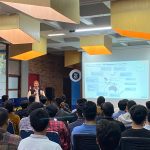Bali Moves to Avoid Traffics, Intensifies SUMP Development Program
Bandung- Facilities are important as a bridge of acceleration in all forms of activities in the country. One example of such facilities is public transport, which is becoming less popular. The use of public transport is inversely proportional to the pace of the economy in Indonesia; because people prefer to use private transportation rather than public transportation. Consumer demand for two-wheeled and four-wheeled vehicles is increasing, while the area of the road is difficult to expand. But in essence, public transport serves to reduce the use of private vehicles, congestion, and even air pollution. In an effort to optimize facilities in the transportation mobilization sector, the Faculty of Mechanical and Aerospace Engineering (FMAE) of Institut Teknologi Bandung (ITB) organized a public lecture to socialize the KRL and LRT development programmes.
On Thursday 2 November 2023, FMAE ITB had a guest from the Bali Provincial Transportation Agency to give a public lecture. The material in the public lecture was presented directly by the Head of the Bali Provincial Transportation Agency, I Gde Wayan Samsi Gunarta, M.APPL.SC. On his occasion, he conveyed about the KRL development programme in Bali Province. Participants who attended the lecture were from the FMAE Magister programme. This public lecture was also held as a form of invitation to students and superior human resources to support the development of public transportation both in Bali Province and in Indonesia.
In the presentation delivered by I Gde Wayan, he mentioned that Jakarta is the only city with the most optimal use of public transportation in Indonesia. Other regions have not implemented this because the level of congestion can still be overcome and the urgency and sensitivity of the community to use public transportation is still low. However, as time goes by, the number of vehicle growth will continue to increase and cause delays in mobilization in Indonesia, one of which is on the island of Bali.
Bali Island, as the center of foreign tourist destinations in Indonesia, aggressively implements the Sustainable Urban Mobility Plan (SUMP) development program in Denpasar, Badung, Gianyar, and Tabanan (SARBAGITA). This is conducted as a preventive measure from congestion caused by population growth and foreign tourist visits. In his presentation, I Gde Wayan said that the need for two-wheeled and four-wheeled vehicles is increasing, even per family can have up to five two-wheeled vehicles. This has not been added to the increasing use of electric bicycles for daily use in Sarbagita.
Based on data taken from 2000 to 2020, the expansion of Sarbagita City increased three to four times. Population and employment are spreading throughout the Sarbagita region across administrative boundaries. With private vehicle growth of up to 7% per year, the Sarbagita region is prone to traffic jams. This can affect the Sarbagita GRDP, which accounts for 65% of the economy on the island of Bali.
The Sarbagita region is a national strategic area that is also a semi-metropolitan city that houses approximately 58% of Bali’s total population. From the 4.2 million Balinese population, 2.9 million people live in Sarbagita, and this number has not been accumulated with the four million tourist visits per year. Without effective and efficient transportation mobilization, this could result in losses of 65 trillion per year.
Therefore, I Gde Wayan delivered his presentation on the Sarbagita Sustainable Urban Mobility Plan (SUMP) program. The vision of the Sarbagita SUMP is to realize Sarbagita metropolitan transportation that is integrated, connected, cultured, sustainable, and humanist to realize the well being and happiness of the Balinese krama. With the realization of this program, it can be an economical and environmentally friendly solution that carries out climate-friendly development and supports the economic activities of the Balinese people.
With this massive SUMP program, there is a great opportunity for FMAE to cooperate and contribute to the development of mobility in Bali. Through this program, the future gateway to Indonesia’s mobility is wide open. The need for advanced human resources will also increase and be directly proportional to the needs of industry and manufacturing both in Bali that is also Indonesia. Hopefully, through this one effort, other efforts will emerge as a way to accelerate Indonesia into the future.







